For several months the V&A and the Institut Valencià de Conservació i Restauració de Béns Culturals (Valencia, Spain) have been working together to discover more about the Altarpiece of St George, displayed at the west end of gallery 48A, better known as the Raphael Court. This is a remarkable example of the Valencian school in the ‘International Gothic Style’, which combines medieval and Renaissance elements.
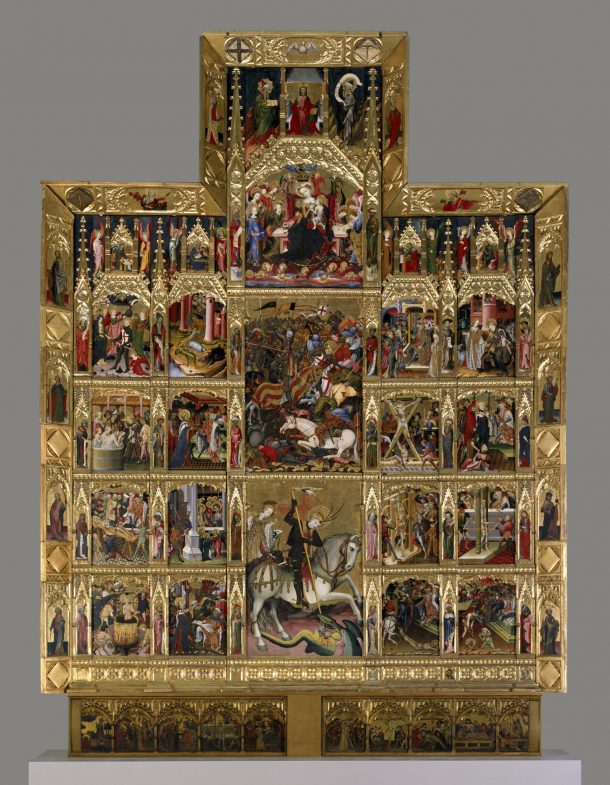
The altarpiece was purchased for the museum by J.C. Robinson in Paris in 1864. As the first curator of the V&A Robinson, along with the museum’s first director, Henry Cole, art dealer William Blundell Spence, and collector Charles Drury Edward Fortnum, made significant acquisitions for the museum in Paris during the 1850 and 60s. During this time, several important French collections were put on the market and, with substantial buying power, Robinson and his colleagues were able to secure great works of art including this altarpiece.
Ever since its arrival at the museum, there has since been much discussion over its attribution. In the early 20th century, it was thought to be by Andrés Marçal de Sas (about 1393 – 1410), a German painter who worked in Valencia. Despite the unity of style, it has been suggested that it was the work of several hands, Pedro Nicolau (active 1390 – 1408), Gonzalo Perez (active 1405 – 23) and Miquel Alcanyís (active 1408 – 1447). More recently, the Spanish artist ‘Master of the Centenar’ has been cautiously suggested (active during the first quarter of the 15th century). This name stems from the commission, which probably came from the Confraternity of the Valencian civic militia, known as the ‘Centenar de la Ploma’. This company of archers (centenar) was dedicated to St George, whose life provides the primary narrative for the altarpiece.
St George was a Christian warrior saint said to have lived at the end of the 3rd century. The 16 panels on the right- and left-hand sides of the altarpiece illustrate the victory of the saint over the dragon as well as his torture and eventual martyrdom. In the upper register, the Holy Spirit is shown above a depiction of Christ flanked on either side by the prophets Moses and Elijah. The following row of panels depict the four apostles, St John, St Luke, St Mark and St Matthew, with the Virgin nursing the Christ child at the centre. The large, central panel shows the defeat of the Moors by a Christian army during the 13th century at the Battle of El Puig near Valencia, and the panel beneath this illustrates St George’s famous defeat of the dragon. The predella, the two panels that run along the bottom of the altarpiece, depicts scenes from the Passion of Christ, the last moments of Jesus Christ’s life.
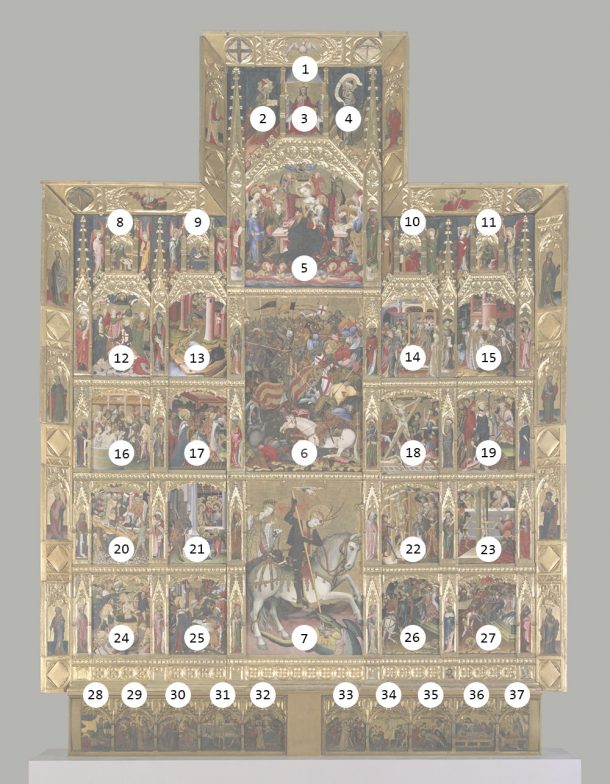
1. The Holy Spirit
2. Moses
3. Christ
4. Elijah
5. The Virgin nursing the Child, crowned by Christ and surrounded by angels
6. A Christian Army under James I of Aragon defeats the Moors with the help of St George at the Battle of Puig in 1237
7. St George fights the dragon
8. St John
9. St Luke
10. St Mark
11. St Matthew
12. St George armed by the Virgin and Angels
13. Silene, Libya: a sacrifice to the dragon
14. Sacrifice of the King’s daughter
15. St George ties the dragon with the Princess’s girdle
16. The King, Queen, Princess and the people of Silene are baptised
17. St George denounces the pagan gods before Dacian
18. St George is tortured tied to a cross
19. St George survives prison
20. St George is tortured on a table
21. St George is put in prison
22. St George is tied between two wheels
23. St George is tied between two posts and sawn in half
24. St George is tortured in a cauldron
25. St George prays
26. St George is drawn naked
27. St George is beheaded
Predella
28 – The Agony in the Garden
29 – The Betrayal
30 – Christ before Caiaphas
31 – The Flagellation
32 – The Mocking
33 – Christ Bearing the Cross
34 – The Crucifixion
35 – The Deposition
36 – The Entombment
37 – The Resurrection
This collaborative project came about when our Spanish colleagues, prompted by the 600th anniversary of the Generalitat Valenciana in 2018, asked to borrow the predella to carry out in-depth technical research into the materials and techniques used by the artist. Working with the V&A’s paintings conservator, Nicola Costaras, they have started to research and conserve the two panels. Nicola recently visited Valencia to see the work carried out so far and discuss the programme of treatment.
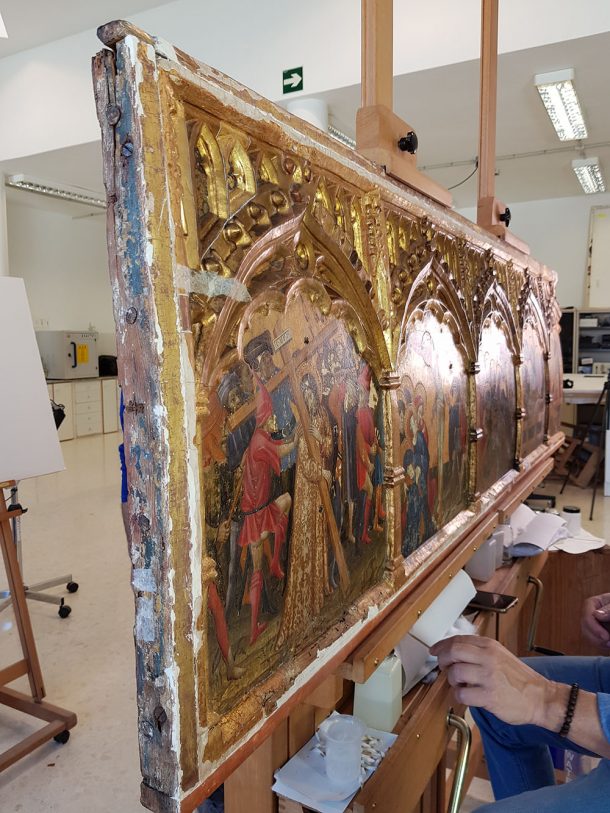
One of the first discoveries the conservators have made concerns the tracery, the decorative woodwork that runs across the two panels. They established that the whole predella, including the tracery, was carved from the same piece of wood. This accounts for its good condition today and demonstrates immense skill on the part of the carver.
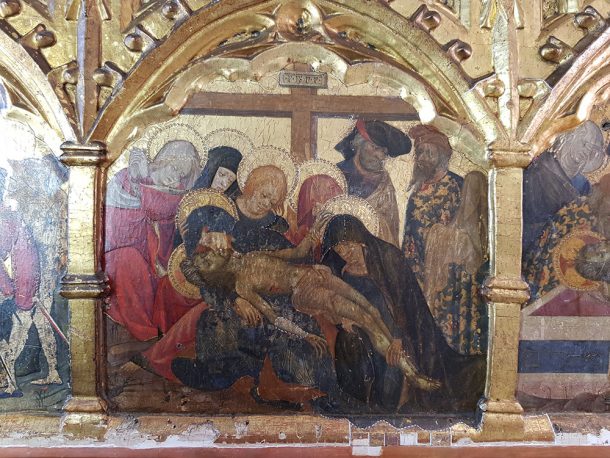
The conservators also found traces of highly prized pigments, including lapis lazuli (no. 4, below) which provides the intense blue found in some of the decorative elements below. Much of this is now lost, but it is still possible to see the intention of leaving unpainted islands of gilding – the punched and tooled areas – to glint in the light.
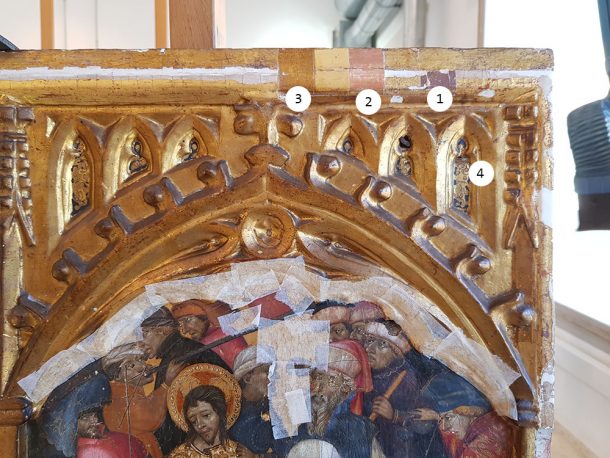
This photo also highlights the team’s investigations into the process of gilding – and later campaigns of restoration. At some point, the strip of wood at the top of the panel was added and the join was rather haphazardly covered with gesso (a plaster-like material used to prime wood panels). The original warm red bole (the pigment applied to the gesso before gilding) is visible in areas where the gilding has worn away (no. 1). Later attempts to match this colour have been revealed in sections. The area of purple bole was applied at a later date (no. 2) and then the pinky terracotta colour (no. 3) shows an even later attempt to match the colour of the original bole.
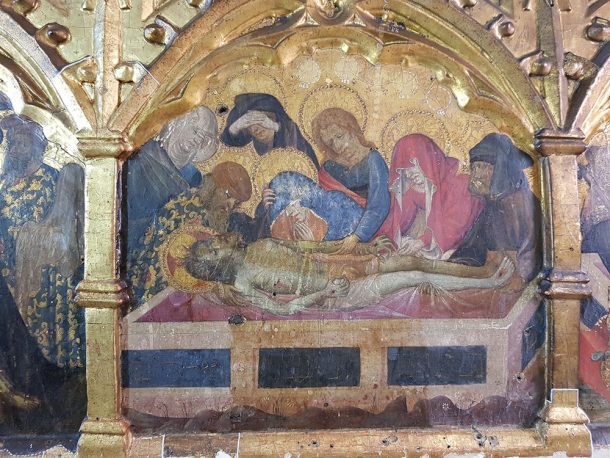
Tests are now being carried out to decide on the best way to clean the surface, which is complicated due to the inconsistent layers of varnish throughout. These tests, visible in the image above, offer a tantalising glimpse of what we can expect to see when the treatment is complete. The image below shows the facing paper applied to the surface to ensure that the gesso is secure in areas where there are cracks in the gilding.
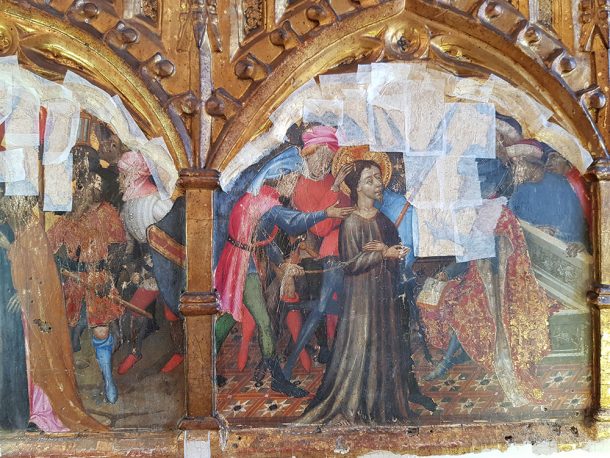
As work continues on the predella we look forward to discovering more about this important work of art in the V&A’s collection.



Excellent work of art and looking forward to the final restauración .
I would like to know if posters of this altarpiece are available for purchase. Three official buildings in Catalunya are interested in acquiring some as it depicts a story related to the Catalan and Valencian Culture.